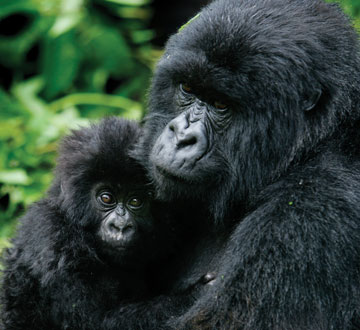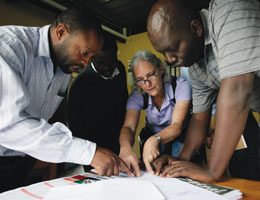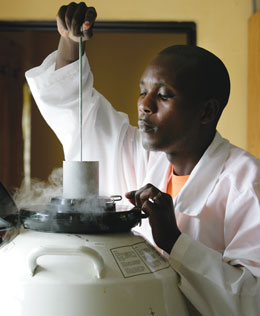Volume 29 · Number 1 · Fall 2011
One Health
Gorillas in Africa's Virunga Mountains are increasing in numbers with the help of a UC Davis program that looks after people as well as the endangered apes.

Magahane, a mountain gorilla, holds her 7-month-old female infant in Volcanoes National Park in Rwanda. (Don Boroughs photo illustration. UC Davis home page photo illustration by Don Boroughs and Jay Leek)
MUSANZE, Rwanda—In a forest glade on the slopes of Rwanda's Mount Sabyinyo, a young mountain gorilla named Uburanga sidles up to a smaller companion, Asagaro. Five-year-old Uburanga gently lays his hands on Asagaro's furry head, as if to give a blessing. Instead, he topples his playmate and sits on top of him—king of the mountain.
Watching this playful scene in Volcanoes National Park is Jean-Felix Kinani, a field veterinarian for the UC Davis Mountain Gorilla One Health Program and the Mountain Gorilla Veterinary Project. Uburanga's bravado gives Kinani a special delight, for he remembers the afternoon, two years ago, when he found Uburanga clinging to his mother's lifeless body and screaming in fear. Coughing, congested and far from his clan, Uburanga, whose name means "the beauty," seemed destined for the same fate as his mother. Kinani worked hastily with a team of veterinarians and assistants to dart Uburanga to tranquilize him, treat him with antibiotics and return the youngster to the protection of his group.
Now, the death of Uburanga's mother has taken on historic importance with the recent publication of a paper by two UC Davis faculty, among others. The article, in the journal Emerging Infectious Diseases, provides the first genetic proof that a dead mountain gorilla had been infected by germs spread from humans. This revelation is both a call to action and an affirmation of the mission of the UC Davis Mountain Gorilla One Health Program: to promote the survival of these endangered apes by looking after people, as well as the gorillas in their midst.
"Disease is the No. 1 threat to their existence," says Mike Cranfield, co-director of Mountain Gorilla One Health and one of the paper's authors. "It's a perfect storm." The apes number fewer than 800, divided into two isolated populations. They share 98 percent of human DNA, making them susceptible to many of the same diseases. And a low stone wall, regularly crossed by both gorillas and people, is the only buffer between the forested park and densely populated, poor farming communities beset with ill-health. "On top of all that," Cranfield adds, "people come from all over the world to stand for an hour within seven meters of them; each gorilla is visited by over 2,000 people per year!"
The lifesavers in this storm are the veterinarians of the Mountain Gorilla Veterinary Project, who for 25 years have been monitoring and treating mountain gorillas. Three years ago, the project was looking for a partner with the experience, connections and research expertise that could advance its work to a new level. Cranfield, then the project's director, as well as head of research and conservation at the Maryland Zoo, says, "There was no doubt in anybody's mind that UC Davis was the right spot; they had a world-renowned Wildlife Health Center, and had experts in many diversified fields that we could rely on." Indeed, Linda Lowenstine, a veterinary pathologist at UC Davis, had already been analyzing gorilla tissue samples for the project for more than two decades.
Cranfield has now joined the UC Davis faculty, co-directing Mountain Gorilla One Health and the project with Kirsten Gilardi, also of the veterinary school's Wildlife Health Center. The university and the project share the financial burden of their work with gorillas, aided by a $750,000 Packard Foundation grant.
Cranfield spends much of the year at the gorilla doctors' headquarters, in northwestern Rwanda. Dormant volcanoes of the Virunga Mountains form the backdrop for the converted house where the gorilla doctors have their offices and laboratories. Four veterinarians, including Kinani and Cranfield, work here, with another five tending to mountain gorillas in the Democratic Republic of the Congo and Uganda.
Thirty-three groups of mountain gorillas are habituated to human contact. All gorillas in those groups receive a monthly checkup from their doctors, though the examination room is the rainforest and the physicals are conducted from more than seven yards away. On the day that Kinani was watching Uburanga cavorting, the veterinarian observed each of the 16 gorillas in the Hirwa clan. He noted that two infants had blisters on their lips, a possible sign of herpes, and suggested to a colleague that these be monitored.
Kinani carried with him a sheet identifying each of the members of the Hirwa group by its unique noseprint, but often didn't need it. "I've known them since they were babies; it's like my family back home," says the 39-year-old father of two who lives in Rwanda's capital, Kigali.

Jan Ramer, regional veterinary manager with the Mountain Gorilla Veterinary Project, center, meets with government officials and a Park veterinary technician regarding human diseases that could spread to mountain gorillas. (Don Boroughs photo)
The veterinarians will intervene only rarely, most often shooting antibiotic darts into gorillas at risk of dying from respiratory diseases or untangling and treating apes caught in the snares poachers set for antelopes. "Only six to 10 times a year do we touch a gorilla," says Jan Ramer, the project's regional veterinary manager. "And we take every sample known to man if they're anesthetized. They [the samples] are like gold."
Back at headquarters, lab manager Jean Bosco Noheri analyzes many of the samples with a microscope, while others are stored in liquid nitrogen until they can be flown to Davis for further analysis. All dead gorillas are given a necropsy, an animal autopsy, at the lab before being buried. In July 2009, Kinani cut into the lungs of Uburanga's mother, and was horrified to find them encrusted with scar tissue from a previous respiratory outbreak, inflamed and clogged with mucous. "They were the worst lungs I have ever seen," says Kinani, who has performed dozens of necropsies. Samples from those lungs were forwarded to Gustavo Palacios at Columbia University, who performed the genetic sleuthing that revealed the source of her affliction.
"I had no doubt that it was human," says Magdalena Braum, a Polish-born project veterinarian who worked with Kinani in the midst of that scourge. She based that hunch on her experience with more than 50 respiratory outbreaks among chimpanzees and gorillas. Braum says the outbreaks tend to fall into two categories. In some, a minority in a group will show mild symptoms and infants will be little affected. This suggests that the germ is probably native to apes, with antibodies passed on through mothers' milk. "It's like flu in kindergarten," she quips. "Nobody's going to die."
By contrast, the Hirwa group that month was a pitiful sight. All 13 gorillas were coughing and two died, including a nursing infant. Its mother, too weak even to eat, simply dropped the tiny corpse, which was picked up by another female and carried for two days. Normally rambunctious youngsters sat with their heads in their hands, eyelids drooping. A 2-year-old with clogged lungs was gasping for oxygen, breathing at more than twice the normal rate.
"This was very severe," recalls Braum. "We had no idea what we were dealing with." She and Kinani worked tirelessly to monitor and treat the sickest gorillas. Had they not intervened, she believes half of the Hirwa group might have died.
At his Columbia lab, Palacios determined that the culprit was human metapneumovirus, a common bug that most human children fight off before age 5. On the family tree of the virus, the particular strain that infected Uburanga's mother fits on a branch populated by viruses found in samples from South Africans.
On a stormy April day, Ramer and her team are reviewing disease statistics with the manager of the Kinigi public clinic. Outside, mothers sit on long benches, shielding their feverish children from the damp wind with colorful batik wraps. "Can we go back to 2009 to look at the Hirwa outbreak?" Ramer asks the clinic manager. In those statistics lies a potentially significant anomaly. Uburanga's mother first fell sick just one month after the clinic was flooded with patients infected with "la grippe," French for flu, more than five times the ordinary rate of infection. Is there a connection? "Right now we don't know," says Ramer. "Is disease more likely to come from tourists, or trackers and guides, or poachers?"
Laurie Harris, a UC Davis veterinary doctoral student, intends to clear up such questions. Her ambition is to use genetics to compare the diseases afflicting the apes with those harbored by both tourists and Rwandans and work out how disease moves among those groups. "We can do a better job of managing the risks if we know more about them," says Gilardi, one of Harris's advisers. "That's what we're trying to do at UC Davis."
Clearly, improving the health of local people would help protect gorillas. But Cranfield points out that 350,000 people live in the vicinity of the park, one of the mostly densely populated rural areas in Africa. The UC Davis medical school sends interns to assist in local health programs—but making a large impact on such vast numbers of Rwandans is currently beyond the scope of the program.

Jean Bosco Noheli, regional laboratory technician for the Mountain Gorilla Veterinary Project, stores blood and other samples from gorillas in a tank of liquid nitrogen for later testing at UC Davis' Wildlife Health Center. (Don Boroughs photo)
Instead, the Mountain Gorilla Veterinary Project and Mountain Gorilla One Health focus their efforts on the more than 400 people in three countries who are in regular contact with the apes. Their Gorilla Conservation Employee Health Program treats these trackers, guards and porters to an annual check-up of a thoroughness that few in Africa—or even the U.S.—enjoy. Lab tests on blood, urine, feces and sputum screen for more than a dozen diseases. Vaccinations and deworming pills protect against several more. The park employees even receive vision tests that have put some of them into glasses for the first time in their lives. Eight workers literally owe their lives to the program, which discovered their HIV and paid for antiretroviral drugs until the government AIDS program could take over. Says Jean Paul Lukusu, who manages the Employee Health Program: "You can't do the conservation and forget the people."
Still, the gorilla doctors cannot screen each visitor on a daily basis. So trackers and tourists are supposed to stay more than seven yards away from the gorillas—just beyond the distance a sneeze travels in still air. Gorillas, however, routinely ignore the rule, nonchalantly approaching visitors. For more thorough protection, veterinarians and trackers in Rwanda who are not accompanying tourists wear surgical masks in the presence of gorillas. In the Democratic Republic of the Congo, tourists also wear masks. And in Tanzania's Mahale Mountains National Park, masks were introduced for tourists and workers in 2006 after three respiratory outbreaks in four years killed several chimpanzees. Since then, such severe scourges have not revisited the chimps.
The One Health concept also addresses risks to wildlife from domestic animals. Five years ago, Cranfield and Kinani devised a rabies reduction program that now vaccinates more than a thousand dogs a year. The vaccinations may save gorillas—dogs regularly sneak into the forest to hunt—and certainly are saving the lives of children bitten by dogs.
The best evidence that the gorilla doctors are making a real difference surfaced in a census taken last year of gorillas in the Virunga Mountains, which run along the borders of Rwanda, Uganda and the Democratic Republic of the Congo. Overall, the population has climbed by an amazing 26 percent since 2003. And the number of habituated gorillas grew five times faster than those in groups that are not monitored.
Eugene Rutagarama, director of the International Gorilla Conservation Program, says credit most likely goes to the veterinarians. "They know Gorilla A had diarrhea, and if Gorilla B is coughing, we know he's coughing. It's better than we look after a human being," he says with an awkward laugh. Indeed, the ratio of doctors to Rwandans is 1 to 18,000, while each gorilla veterinarian is shared by just 65 animals. Rutagarama acknowledges the imbalance, but notes, "The mountain gorillas are an endangered species, and we are not."
So far, luck and the veterinarians have been on the side of mountain gorillas, but Ramer cautions against complacency. "One outbreak could decimate the whole population," she warns. An apocalyptic anecdote comes from the Minkebe Forest of Gabon. Two Ebola epidemics appear to have wiped out 98 percent of the forest's western lowland gorillas, a closely related species. For the gentle giants of the eastern highlands, the UC Davis Mountain Gorilla One Health Program could be the thin line between survival and extinction.
